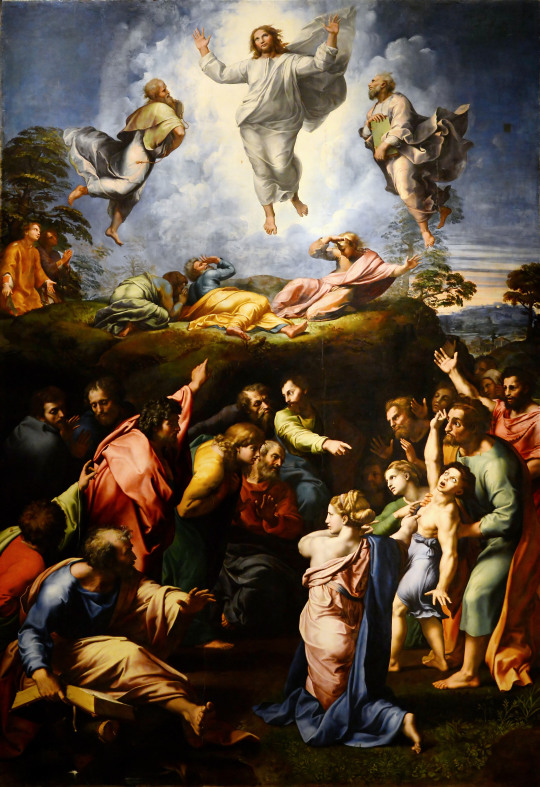
Raphael, Transfiguration, 1516-20
Matt Donovan on the Work of Kate Carr
In Raphael’s Transfiguration, above the bunched-up folds of monochrome robes, above all those gesticulating hands, above Mount Tabor rising up like a little dough-dented knoll just a few feet above the earth, a man has become light and hovers midair and—this is not how we know it to be—remains light forevermore.
Here is the story in brief: not long after ascending the mountain with three of his disciples, Jesus became like the sun. It was, scripture tells us, as if his very flesh turned to light. The spirits of Moses and Elijah appeared, and Peter pledged to build three tabernacles for prayer, and a cloud wafted forth, demanding we pay heed, and the disciples pitched forward in fear, transfixed.
Yet, as always, the light didn’t last, and soon enough they were all threading down the mountain’s switchbacking trail. Soon enough, too, they encountered a man within a crowd who begged Jesus to cure his ailing son, and then the talk turned from all that impossible light to the path of mortal flesh.
In one photograph—perhaps this was just before she was diagnosed?—Kate stands in the doorway of her studio. It’s one of those dazzling, sun-soaked New Mexico winter days, and behind her the sky is a searing, cloudless swatch of blue. Dressed in a black shirt, black jeans, and a nearly fluorescent fuchsia down vest, she’s flashing one of her beaming, all-in smiles even as she squints in the glare. Although she’s leaning against the door’s frame, one leg is angled forward, as if she were already in the act of stepping away from this snapshot’s pause, already pivoting back into her studio where she’ll begin once again stacking, cutting, aligning, sewing, making some soon-to-be-beautiful new thing.
Some quibble that the Transfiguration’s light falls short of the criteria for a miracle. Apparently mere radiance is not enough, especially when compared to Lazarus beginning to breathe once again or that water darkening into wine. Moreover, it’s been said that the moment of brilliance and change just didn’t last long enough.
For others, though, that brevity, that temporary suspension of the natural order, is one of the defining characteristics of the miraculous. How long, after all, could the blindsiding last before it became simply the way things run?
In one of Kate’s sculptures, white cloth has been coiled into a small wooden frame. It’s a compact piece—just a foot long, perhaps six inches high—and the fabric seems to both resist and embrace its box-like constraints: the cloth curves in crimped little waves, then doubles back on itself in dramatic whorls. It reminds me of stretched taffy or a Van Gogh sky, of batter poured into a pan, of intestines or thumbprint swirls.
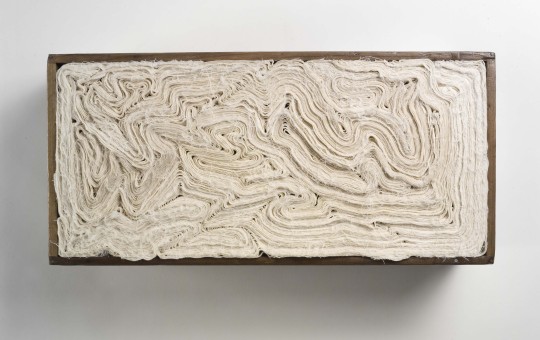
Kate Carr, Muslin Box 3, unbleached muslin, found box, 2007
A quick Google search sends me to Wikipedia, which links me to chapter 9 of the Gospel according to Mark, where this time I’m confounded less by the Transfiguration’s narrative (yes, even that talking cloud and the spirit of Moses paddling air) than simply the scripture’s matter-of-fact tone. While the moment would seem to lend itself to a speechless awe, the Bible’s description strides through similes at a quick clip, as if cocksure each word will get it right.
Thus we’re told a man became as luminous as the sun. His robes, caked with trail dust just a moment before, turned white as snow. Exceedingly so, the scriptures insist. His robes—behold—in fact became whiter than any fuller on earth might bleach them.
Because the painting has become so familiar (its showcase status in the Vatican Museum; the painting’s own nine-year transfiguration into a eighteenth-century mosaic installed in Saint Peter’s Basilica), it’s easy to overlook how seriously strange Raphael’s Transfiguration is. Look again at its clutter of color, that confusion of hands, the baffling conflation of time and space. Although the transformation itself occurs on the mountain peak, and although in the Bible the crowd greets Jesus only after he’s tramped back down Mount Tabor, the two moments in the painting seem to be taking place at the same time, so that foreground and background, miracle and aftermath, fleeting light and convulsing boy are unfolding all at once.
Some in the crowd point at the man hovering in the light, some point at the flailing child. Some shield their eyes or clutch their chest, overwhelmed by it all.
Minimalist art doesn’t always speak to me, and, depending on which varnished cube or fluorescent light cluster I’m looking at, I can find myself feeling twitchy while trying to contend with the stubborn reticence of some rarefied object.
With Kate’s spare and haunting work, however, I’ve consistently experienced a kind of quiet rapture, most especially with her sculpture entitled Through. The piece could hardly be simpler in its composition: thin strips of Baltic birch plywood are compressed together to form a mounted board about three feet long, and a small length of gray wool felt, positioned behind the wood, has been slit in two places so that the board slips through it.
The first time I saw it, I found myself transfixed by its collision of shape, texture, and form. The wood’s accruing striations stand out against the felt’s uniform gray, and the fabric’s soft fin-like shapes droop in contrast to the wood’s unwavering, ruler-straight lines. It would be a corny contrivance, of course, to endow this piece with a voice, and yet to my mind this sculpture has always seemed to quietly insist that its own unlikely, uneasy harmony is the only harmony on earth to be had.
As you stand beneath the gridded domed glass ceiling of the Vatican Museum’s room number eight, gazing up at The Transfiguration from behind the roped-off barrier, the painted light that surrounds Jesus looks radiantly white. Whiter, yes, than any bleached robes imaginable, whiter than the snow hurling down outside my window just now. It seems whiter than a heap of sugar or a globby White-Out smear—for how else but through the lens of the earthly can we ever understand the divine?—or even Marilyn’s dress above the subway vent gusting around her thighs.
All these comparisons fail, of course, but for reasons beyond my own ill-chosen words. When I page through a book of close-up reproductions of the painting, it’s clear that Raphael’s light is made not merely of a glistering white. Rather, it’s speckled with age, and bristle-streaked, and composed of hints of blue and what looks like a mustardy ochre.
“I choose to cut my materials by hand, when possible, so that within this fairly mundane stacking process there is room for the unexpected,” Kate has written about her work. “The inescapable imperfection of something cut by hand (or drawn by hand) has its own irregular, flawed beauty that gives the work a human quality I find necessary and inevitable.”
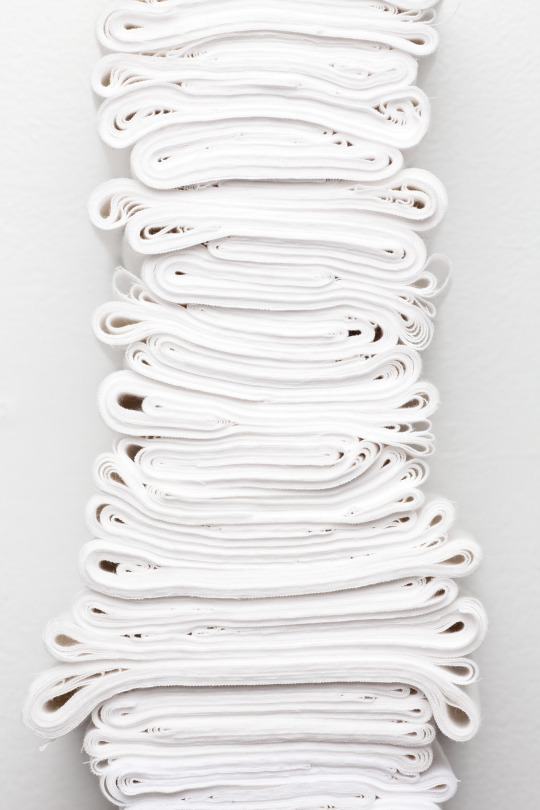
Kate Carr, detail of Muslin Coil, muslin, 2010
There are two things I remember vividly about the funeral of a high school friend who died from a brain tumor many years back. One was the shock of seeing her embalmed body in the open casket, how her distorted face seemed like some amateur sketch of the woman I had known and adored. The other was walking out the parlor’s back door and, on impulse, striding over to an evergreen at the edge of the parking lot, yanking off a fistful of needles, and breathing in the scent of pine.
Here, it seems to me, is one possible paradox of loss. At times, those proximities to death, those sudden intimations of mortality, seem to heighten our awareness of the world that surrounds us. Then again, grappling after that same “now-ness” can also lure us away from the person we’re grieving for. Pine scent gives way to a cardinal’s scarlet flare, followed by wind-twitching ditch grass or the precise hook-shaped back end of an otherwise bulbous cloud and countless other minute scraps from the world of ten thousand things.
No matter the spirit of that turning away, it’s a departure nonetheless, one as clear-cut as the moment Auden traces in his poem about Brueghel’s painting of Icarus. There, a winged boy plummets from the sky, and while many don’t notice his descent at all—the ploughman continues to guide his blade through earth, dogs stutter on with their little doggy lives—the passengers aboard a ship witness what takes place. They see something amazing, and yet the sea is still rippling in the spot where the boy disappeared before those on board remember they have somewhere else to be, and calmly sail on.
Some early critics felt that The Transfiguration ignored basic artistic principles of harmony and coherence: the mind must parse and cleave the narratives (one about light, one about human frailty) at the same time that, we’re expected to understand, the two parts need to be addressed as inseparable pieces of the same story. It’s as if Raphael has created a kind of cinematic split-screen without bothering to split the screen.
Goethe, on the other hand, far from being disturbed by Raphael’s contortions of space, felt that the painting’s two halves needed each other, like a yin solemnly spooning a yang. Through adjacency and simultaneity, a dialogue between agony and transcendence is forged. Besides, should you require the verisimilitude of a horizon, Raphael has provided that too: there it is, crammed into a center-right sliver of the canvas, set off into the deep distance, miles behind the darkened branches of some shaggy-leafed tree. Back within that blue haze, there’s also a glimpse of city walls, nearly indistinguishable from the shrubby hillside, and perhaps serving as a reminder of all the bruised bodies and unhealed flesh that Christ, after becoming pure light, will neither encounter nor cure during his mountain descent.
About suffering, they were never wrong, the Old Masters.
Although given what X-rays and drafts of Raphael’s painting reveal, he was apparently wrong many times. At one point, those awe-struck apostles who shield their eyes on Mount Tabor’s summit were going to be rendered entirely nude. At one point, rather than painting him floating midair, no longer quite of our element, Raphael was going to depict Christ gleaming bright but with his feet perched on a lumpy boulder.
Perhaps I should clarify: Raphael’s struggle with the painting’s composition didn’t take place within the darkened lower half where the crowd gathers around the wild-eyed boy. Instead, all his reworking and uncertainty took place in the realm of light.
At first, we knew only what Kate had chosen to announce to friends: the cancer had spread through her body and no one was sure if the chemotherapy would work. In the feeblest of gestures, and since there was no clear sense of what else to do, my wife and I made a pot of minestrone soup that I drove across town and left on her doorstep. For a long time, I sat behind the wheel of the car, staring at the light that fell indiscriminately on her house, the sidewalk, the parked cars and trees, the shattered glass at the bus stop, the charred yellow sun of the Burrito Spot’s sign down the block. That light which is everywhere, and promises nothing, and forces us to guess what it means.
Home, a piece that Kate installed in a gallery in Vermont, is a semi translucent tent-shaped structure made of sailcloth. Its design is simple, as if a child’s drawing of a house were somehow inflated and left to hang balloon-like from the ceiling where it dangles aglow, seemingly weightless, illuminated by two lights inside.
Despite its title, however, and despite its beacon-like gleam, I can only see the place that the piece depicts as inhospitable. It hovers not far from the gallery floor, lovely to look upon and seemingly welcoming with its warm light; at the same time—and perhaps like any vision of heaven—it remains out of reach, unable to support any real human weight, sealed shut with long seams of dark stitches. In order to depict that holy light, Raphael would have used a blend of toxic lead white that, not long after the artist’s death, we know began to change.
Year after year, dust dimmed its glow and actual light bleached the painted scene. Tiny cracks in the pigment began to spread, and eventually the piece would need to be fumigated with formaldehyde after woodworms devoured the cherry-wood frame. By the time it was determined that its transfiguring light needed to be restored to what it once had been, it was fly-specked and had been slathered in a noxious, damaging varnish that someone had mistakenly believed would let the light carry on and on.
The purest white?
Forget what you think you know. There’s a piece by Kate comprised of nothing but blank sheets of paper, arranged in loose folds, spiraling down from the ceiling. Or there’s the white of her PillowBusts, a series of halved pillowcase casts made all the more white through their arrangement on pedestals painted sky blue. Each bust, with its own unique crease and curve, lilt and sag and dimpled spot where a head once lay, seems to embody the concept of “pillow” as a Platonic ideal.
At the same time, each one begins not to seem pillow-like at all, resembling instead billowing sails, fossilized clouds, or ancient torsos sanded and smoothed until some abstract essence of body is achieved and the sculpture teems, simmers, dazzles, and brims the way Rilke described that bust of Apollo.
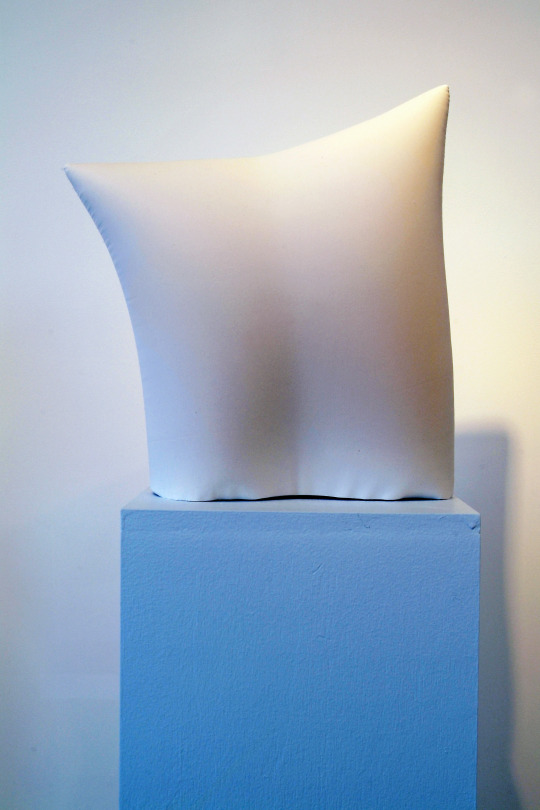
Kate Carr, Pillow Bust, cast plaster, 2006
Perhaps that’s a story you know: after watching Rodin pound and chisel marble slabs each day, Rilke vowed to stop gauzing his work with abstract emotions and instead to tether his poems to things. After first tackling a panther striding behind bars at the Paris zoo, he turned to that statue at the Louvre where the torso “is still suffused with brilliance from the inside, / like a lamp, in which his gaze, now turned to low, / gleams in all its power.” Or, Rilke writes, also allowing his similes to accrue, it glistens like a wild beast’s fur, like a burst star’s fires. If the comparisons don’t quite mesh, it matters little in the end; instead, it’s the sheer act of looking that fuels the statue’s imagined voice in those fierce last words: “You must change your life.”
Whenever I look at Kate’s work, I feel some paraphrase of that blindsiding command, not because her art seeks the kind of thunderous oracular voice that Rilke’s gazed-upon statue employs, but because her distillation of process, her seriousness of intent, her tenacious acts of looking, put my own flailing attempts at making to shame. Today, enraged by the fact of her illness, I go further still: given how they never seem to sit in silence, then sit and look some more, given how, in all our tales, they transform and take, avenge and glide, choose when to heal and when to cure nothing at all, I tell you it’s the gods whose lives must change.
The Latin inscription over Raphael’s tomb in the Pantheon is well known: “Here lies that famous Raphael by whom Nature feared to be conquered while he lived, and when he was dying, feared herself to die.” Less clear is how to respond to its lies.
Where to begin? With investing Nature with human pettiness and mortal fears? With that implied privileging of one life above all others?
Or perhaps with the inscription’s mischaracterization of Raphael’s work as just a mirroring of the natural world. Believe me: this is no art-speak quibble. If some of his paintings give back sun-teeming branches or a wind-pummeled cloud, there is of course more to tell.
After the discovery of Nero’s palace—an unexcavated ruin that had remained essentially intact—artists would pilgrimage to a hole in the earth and descend by rope into long-buried rooms in order to view wall paintings the ancients had left behind. Raphael, too, was lowered in several times, and made use of many of those shape-shifting forms for his painting of the Vatican’s arches, ceilings, and walls. In that decorative work—“grotesques,” we call them—red vines loop into angels that curlicue into taffy-like griffins with donkey-eared heads that sprout into fountains or perhaps feathery lozenges knotted to garlands laced around a bridge composed of bone-shaped bricks.
Thus yet more poorly lit, inscrutable beauty, yet more lawless whim.
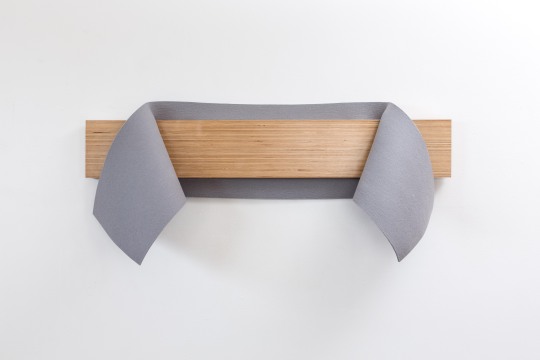
Kate Carr, Through, Baltic Birch Plywood, wool felt, 2012
During a window of time in which Kate felt well enough to see friends, we drove by her house again, delivering a loaf of bread, a spinach quiche, half a dozen yellow tulips. She greeted us at the door wearing a self-knitted yarn cap snug on her now-bald head, and seemed frail but also luminous in a way I wouldn’t have imagined. For the first time since her diagnosis, her doctor was pleased with the latest rounds of tests. In that moment, she seemed chatty, wanting to gossip, catch up, ask about our newly adopted coonhound. And she wanted to describe her chemotherapy sessions, how they were using platinum to attack the cancerous cells. Whenever she felt well enough, she said, she’d take short walks, thinking about what it means to have that kind of radiance coursing through her blood.
I should confess that I have little love for The Transfiguration. At the same time, I haven’t been able to relinquish it either.
For a while, because the painting remained incomplete at the time of Raphael’s death at the age of thirty-seven, I was drawn simply to the idea of the artist’s last testimony as well as those tales of all of Rome bereft, grieving for the young artist’s passing. The city’s streets were filled with long lines of mourners, I’d read, processing to his tomb at the Pantheon where that last work had been positioned above his head. I imagined how The Transfiguration’s light would have been twinned by the light beaming down from the Pantheon’s oculus, and how, in both the building and the painting, there would have been an illuminated mortal crowd.
For a while, this forged a correspondence that I couldn’t resist. That is, until coincidence and trope did nothing to console or change the news about Kate, and the conceit came to mean nothing at all, and all that was left was the thought of flesh that needed to be cured as light spilled in relentless luster.
“I want my process to reveal the material,” Kate writes, “rather than transform it.”
Which is exactly what she’s done with a new piece that’s an untitled stack of white fabric she’s mounted on a gallery wall. It’s a slender column of uneven lengths of cloth that fold back on themselves. Some strips are layered in loose, untidy loops, some are tucked in tight.
Muslin Coil promises nothing more than the shape and color and texture that it is—line and curve, pattern and lapse, two meandering edges that begin a few feet up from the floor and, hard-earned, rise up a few feet more.
Kate, I’m thinking, is right yet again: the piece, it would seem, changes nothing at all. But here at last is cloth revealed as cloth, here is white as white. Here are things blazing with the way things are.
This essay is an excerpt from A Cloud of Unusual Size and Shape: Meditations on Ruin and Redemption, out now from Trinity Press.




